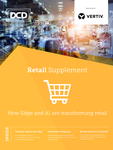If there was any question that digital transformation represents the future of retail, it was answered in 2020. Marked by massive swings in consumer demand and an unanticipated spike in e-commerce, technology became vital to retailers’ ability to serve customers throughout the disruptions created by the pandemic.
Now, as consumers are becoming comfortable with returning to normal activities, retailers face the challenge of maintaining the momentum of their e-commerce channels while simultaneously attracting consumers back to stores. Here again, technology is poised to play a significant role by reshaping the in-store experience to make it more attractive and efficient.
Emerging “smart store” technologies create opportunities for retailers to provide their customers with more engaging and personalized experiences, while eliminating operating inefficiencies that can erode margins. They also have the potential to gain deeper insights into consumer behaviors to drive more effective marketing, merchandizing and forecasting.
Growth of in-store technology
Prior to the pandemic, we’d already seen something of a transformation at the point of sale (POS), as many retailers introduced or expanded self-checkout capabilities. During the pandemic, scan-and-go technologies that enable consumers to bypass checkout altogether also gained traction.
This continuing evolution addresses one of the most consistent consumer complaints about the in-store experience — waiting in lines — as well as providing retailers with the opportunity to increase operating efficiency. But it also increases the risk of shrinkage unless accompanied by complementary security systems. Additional cameras, and in a growing number of cases, artificial intelligence are being deployed with self-checkout and scan-and-go technologies to reduce the risk of abuse.
Those changes represent just the first wave of technology that is coming to many stores. A range of smart store solutions are available today that utilize some of the most exciting and promising emerging technologies such as:
- Augmented and virtual reality for delivering more immersive and personalized in-store experiences for shoppers
- Mobile robotics for everything from restocking of products to cleaning floors
- Video as a tool for understanding customer behavior and improving inventory management via analytics
- Digital signage and smart shelves for creating dynamic environments, enabling quick changes to pricing and marketing messages
Internet of Things (IoT), machine learning, and mobile apps all have retail applications as well. Many of these technologies are data-intensive or latency sensitive. In other words, any lag in the processing of data that happens as requests from client devices are transferred across long distances to servers responding to those requests would negatively impact operations and only serve to frustrate employees and customers. That’s why these technologies require local compute to deliver their promised benefits. Supporting future growth that will accompany the adoption of these technologies may mean giving additional consideration to reliability, scalability, and manageability of the retail edge infrastructure.
Beyond point-of-sale protection
Retailers aren’t unfamiliar with the concept of edge computing and the infrastructure required to support it. They have long deployed edge infrastructure to provide power continuity for POS, communications, and security systems. Since the demands on that infrastructure are increasing, retail sites seeking to use technology to gain competitive advantage will need to deploy a robust infrastructure solution or upgrade the equipment already deployed to increase on-site processing power.
Many retailers have already taken the first step in preparing for this next wave of technology by moving to a centralized power protection strategy for their POS systems. This approach alleviates the maintenance and management challenges inherent with a distributed approach to POS protection in which each system is supported by a separate UPS system.
A centralized protection strategy also creates the foundation for expanded use of technology within the store. Whether you’re considering moving to centralized protection of POS systems, or are auditing your existing infrastructure in preparation for additional technology deployments, here are three ways you can enhance support to ensure maximum availability of retail technology:
- Extend battery life. When configuring power protection for your edge infrastructure, there are multiple things to think about, including the topology and capacity of the UPS system. Working through these considerations helps ensure power anomalies don’t lead to downtime, data loss, or equipment damage and subsequent loss of revenue. But today, there is an additional consideration that didn’t exist just a few years ago: the availability of UPS systems with lithium-ion batteries. These batteries, which already power everything from laptop computers to electric cars, operate at higher temperatures and deliver much longer runtimes than the lead-acid batteries traditionally used in UPS systems. With lithium-ion batteries you can reduce the frequency of battery replacements and lower your total cost of ownership over the life of the UPS.
- Enable remote monitoring: Remote infrastructure monitoring provides centralized IT specialists with visibility into equipment performance across the retail network and can also enable tasks such as remotely rebooting IT systems. When equipped with additional sensors, remote monitoring systems can generate alerts for situations that could put equipment at risk, such as elevated temperatures, water intrusion, or unauthorized access. Remote infrastructure monitoring can be performed through the UPS, intelligent power distribution units, or a dedicated monitoring solution. Devices such as advanced serial consoles and IT visibility platforms are also available to enable remote IT access. Not only does remote monitoring maximize uptime, it streamlines infrastructure management, saving retailers time and money.
- Leverage integration: Particularly in larger retail stores and cases where many edge sites are being upgraded in a short period of time, pre-configured and fully integrated rack systems offer multiple benefits over on-site integration. Today’s micro data center solutions integrate cooling, power protection, power distribution, and monitoring into the equipment rack at the factory. When the rack arrives on site, it’s ready for IT system installation, enabling a quick startup.
Retail stores that survive and thrive in the coming years will be those that use technology to deliver a better customer experience and improve operational efficiency. IT infrastructure is critical to ensuring availability and simplifying management of in-store technology. To learn more, read the Vertiv white paper, Transforming the Retail Edge: Enabling Point-of-Sale Continuity and IT Growth, or visit our website to find the representative nearest you.





